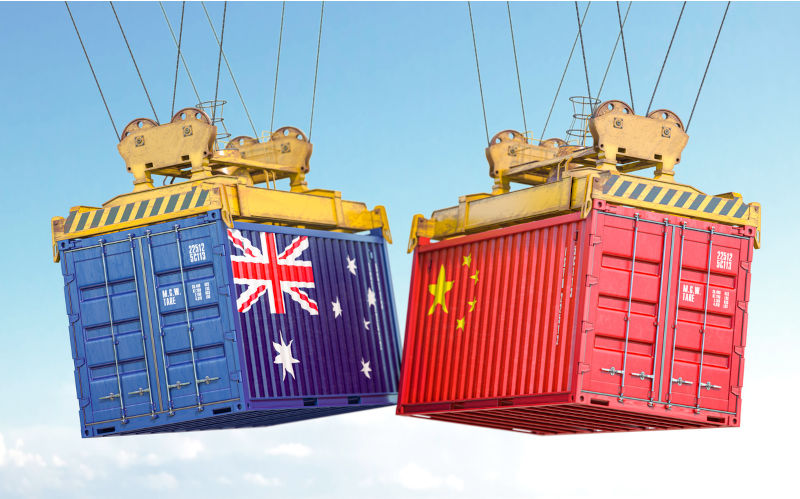Trump 2.0 is in full swing, and tariffs are emerging again as a policy of choice for the president. Trump has imposed or threatened tariffs against all of the US’s top trading partners, including Canada, Mexico, and the European Union.
However, the most significant target is China, which is still subject to the tariffs imposed by the first Trump administration, and which has been hit with another 10%. This is far short of the 60% Trump promised during his election campaign. However, with China already retaliating with tariffs on US energy, an escalation is most likely not too far away.
What does this mean for the Australian economy? It is no secret that China is Australia’s main trading partner. A new US-China trade war would threaten the main market for Australian exports, potentially causing major knock-on effects here that would be felt by all Australians.
Australia’s trade relationship with China gets a lot of attention, but its importance is not always fully grasped. The rapid rise of China during the 2000s inflated the prices of Australia’s commodity exports while deflating the prices of its manufactured imports. The result was a record increase in Australian incomes, even as productivity growth remained sluggish.
Investment flooded into mining industries, including hundreds of billions of dollars from overseas, spurring growth and employment. Another major beneficiary was the Australian Treasury. Tax revenue as a share of GDP was higher under the Howard Government than any other government in modern Australian history, even as it splurged big on income tax cuts, usually given as lump-sum rebates to voters ahead of elections.
The commodity boom eventually drove up inflation, resulting in interest rate rises from 2006. However, inflation was tempered significantly by the flood of cheap Chinese goods. Indeed, Australia was one of the biggest beneficiaries of the so-called “China price”. Even during the height of the export boom, Australia ran trade deficits as we took full advantage of China’s integration into global trade. As the global financial crisis hit, Chinese demand for Australia exports helped us to avoid a recession of the type that afflicted many other Western economies.
This history matters. Access to the Chinese market has had a significant impact on how Australia’s political economy has developed over the past 25 years. It has shaped where our economic resources have been allocated. It has raised our standard of living. It has affected our political culture and our expectations of government.
However, that was then. What about now? In 2020, China banned the import of Australian coal. That year, 17% of our coal exports went to China – a sizeable share. Many assumed that the industry’s devastation would follow the loss of the Chinese market. Yet it didn’t. Australians found other buyers for our coal. By 2021, China accounted for less than 1% of our coal exports, even as Australia’s total exports of coal increased by US$19 billion.
It is important not to draw the wrong lessons from this experience. Energy is important to our trade with China, but our most important commodity is by far iron ore. In 2022, China purchased 83% of our US$88 billion in iron ore exports. Meanwhile, finding alternative buyers for our iron ore would be difficult – China purchased 65% of global iron ore exports in the same year.
It’s not just that China buys a lot from Australia. Our vulnerability lies in how much specific goods rely on the Chinese market, the high share of these same goods of our total exports, and China’s share of the market for these goods globally.
Australia also needs to understand that the threat is not just tariffs, and not just Trump. The US’ political consensus is souring on US-China economic relations. Trump may have started the trade war with China in 2018, but Biden retained the Trump-era tariffs. Trump may have first taken aim at the Chinese technology sector by sanctioning Huawei and proposing a ban on TikTok, but it was Biden who expanded these sanctions to the whole Chinese semiconductor industry and shepherded a TikTok ban through Congress.
China is flexing its economic power too, imposing its own export bans on materials used in semiconductor manufacturing. Rising economic tensions between the US and China is the new normal – and Australia is caught in the middle.
Decoupling from China will be costly for Australia – and not just because of exports. If Australia and others in the US alliance system are not buying their computers, toys, or smartphones from China, then where are they buying them from? Because China accounts for 51%, 63% and 58% of global exports of these products, respectively – and dominates many other markets as well.
Of course, all of this could be manufactured somewhere else, but that would require hefty investment, either in domestic manufacturing or in foreign markets. It is also likely to increase inflation by quite a significant amount, as it is unlikely new manufacturing could be done as cheaply. Meanwhile, Australia will not be able to pay as easily for these higher priced imports as foreign exchange earnings from our commodity exports decline, as will the inflow of foreign investment into the mining industry. This will lower our incomes.
The big risk for Australia is that the US will make increasing demands on its allies to join its efforts. Indeed, we see that happening in semiconductors already. Will Trump, known for his unilateralism and bellicose approach to allies, increase these demands? Can we expect the US to demand we too follow a path of decoupling from China? And what would that mean for our economy, standard of living, and political stability? These are the questions Canberra should be considering.

Madison Cartwright
Madison Cartwright is a Senior Lecturer in International Political Economy and the convenor for the Politics and International Relations undergraduate programme at UNSW. My research interests include the political economy of intellectual property, trade, and the economic-security nexus.
